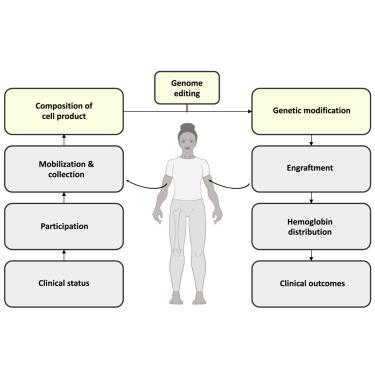当前位置:
X-MOL 学术
›
Mol. Ther.
›
论文详情
Our official English website, www.x-mol.net, welcomes your
feedback! (Note: you will need to create a separate account there.)
Editing outside the body: Ex vivo gene-modification for β-hemoglobinopathy cellular therapy
Molecular Therapy ( IF 12.1 ) Pub Date : 2021-10-08 , DOI: 10.1016/j.ymthe.2021.10.002 Tolulope O Rosanwo 1 , Daniel E Bauer 2
Molecular Therapy ( IF 12.1 ) Pub Date : 2021-10-08 , DOI: 10.1016/j.ymthe.2021.10.002 Tolulope O Rosanwo 1 , Daniel E Bauer 2
Affiliation

|
Genome editing produces genetic modifications in somatic cells, offering novel curative possibilities for sickle cell disease and β-thalassemia. These opportunities leverage clinical knowledge of hematopoietic stem cell transplant and gene transfer. Advantages to this mode of therapy include locus-specific alteration of patient hematopoietic stem cell genomes, lack of allogeneic immune response, and avoidance of insertional mutagenesis. Despite exciting progress, many aspects of this approach remain to be optimized for ideal clinical implementation, including the efficiency and specificity of gene modification, delivery to hematopoietic of gene-modified cells. This review highlights genome editing as compared to other genetic therapies, the differences between editing strategies, and the clinical prospects and challenges of implementing genome editing as a novel treatment. As the world’s most common monogenic disorders, the β-hemoglobinopathies are at the forefront of bringing genome editing to the clinic and hold promise for molecular medicine to address human disease at its root.
中文翻译:

体外编辑:β-血红蛋白病细胞疗法的离体基因修饰
基因组编辑在体细胞中产生基因修饰,为镰状细胞病和β地中海贫血提供新的治疗可能性。这些机会利用了造血干细胞移植和基因转移的临床知识。这种治疗模式的优点包括患者造血干细胞基因组的位点特异性改变、缺乏同种异体免疫反应以及避免插入突变。尽管取得了令人兴奋的进展,但这种方法的许多方面仍有待优化以实现理想的临床实施,包括基因修饰的效率和特异性、将基因修饰细胞输送到造血系统。这篇综述重点介绍了基因组编辑与其他基因疗法相比、编辑策略之间的差异,以及将基因组编辑作为一种新型治疗方法实施的临床前景和挑战。作为世界上最常见的单基因疾病,β-血红蛋白病处于将基因组编辑引入临床的最前沿,并有望通过分子医学从根本上解决人类疾病。
更新日期:2021-10-08
中文翻译:

体外编辑:β-血红蛋白病细胞疗法的离体基因修饰
基因组编辑在体细胞中产生基因修饰,为镰状细胞病和β地中海贫血提供新的治疗可能性。这些机会利用了造血干细胞移植和基因转移的临床知识。这种治疗模式的优点包括患者造血干细胞基因组的位点特异性改变、缺乏同种异体免疫反应以及避免插入突变。尽管取得了令人兴奋的进展,但这种方法的许多方面仍有待优化以实现理想的临床实施,包括基因修饰的效率和特异性、将基因修饰细胞输送到造血系统。这篇综述重点介绍了基因组编辑与其他基因疗法相比、编辑策略之间的差异,以及将基因组编辑作为一种新型治疗方法实施的临床前景和挑战。作为世界上最常见的单基因疾病,β-血红蛋白病处于将基因组编辑引入临床的最前沿,并有望通过分子医学从根本上解决人类疾病。











































 京公网安备 11010802027423号
京公网安备 11010802027423号